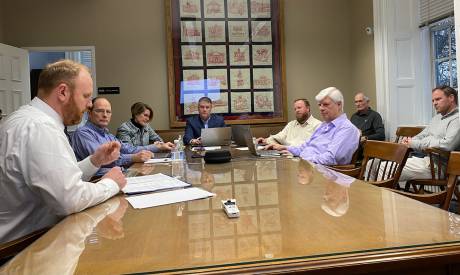
Some county legislators agreed, albeit reservedly, to walk the walk Monday when it comes to participating in a Healthy Places By Design Walkability Academy.
Genesee County Public Health Director Paul Pettit presented the academy program during the county's Human Services Committee meeting. Operated by the Walkability Action Institute (WAI) and Walkability Virtual Academy (WVA), the national-based program is a yearly multi-day course for interdisciplinary teams comprising public health, transportation, planning, and elected officials, Pettit said.
He had received information about a learning academy last November, "where they bring in communities to participate and learn about different strategies and ways to make your communities more walkable, likable, safe, those types of things, active living," he said. He didn’t have enough time to apply then, he said, so he let it go. But apparently, he wasn't the only one in a time crunch around the holidays.
“I got an email a couple of weeks ago that said, ‘Hey, we didn't have enough applicants. If you want to apply, you can be in it, you just have to submit the RFP.’ I talked to (County Planning Director Felipe Oltramari) and my folks, and we felt we could put something together and get it in. It's 12 virtual sessions, there's no travel or anything associated with it, it’s all via zoom, and will allow us to participate …and work on developing some comprehensive planning around this area," Pettit said. “And the goal would be to look at our villages and our city and come up with different strategies,. And in my mind, it's really a way that we can kind of lay the foundation and framework for future funding.”
There are 18 participating groups across the country, and they would each receive a grant of about $5,000, which Pettit admitted wasn’t a huge payoff in and of itself.
“It would allow us to work on comprehensive planning for our villages and the city,” he said. “We would look at sidewalks, crosswalks, signs, things that people find challenging.”
Legislator Gregg Torrey was concerned with the time involvement of team members.
“It seems like a big commitment on our side, for a small grant commitment on their side,” he said.
Fellow Legislator Christian Yunker agreed.
“It seems like a lot of staff time … seems like a significant effort (for what the county is getting).”
The project would probably require five to six people for the academy, including at least one elected official, Pettit said. Yunker clarified that it doesn’t have to be a legislator, and it could be someone from the city, which Pettit confirmed.
Legislator Gary Maha asked if participation would put the county in line for additional funding, and Pettit didn't think so.
No one expressed interest in participating during the meeting, but Legislators Torrey, Yunker, Maha, Gordon Dibble, Brooks Hawley and John Deleo approved Pettit’s request to apply for the program.
According to the Healthy Places by Design website, Healthy Places by Design participates as WAI/WVA faculty and co-facilitates the Community of Practice. The CoP is a peer learning and exchange network of WAI/WVA alumni that continue to build their capacity to implement policy, systems, and environmental changes to make communities more walkable, moveable, equitable, and inclusive. In addition, the team co-designed, drafted, and finalized the Active Community Tool that communities can use to assess local built environment, planning, and policy supports for physical activity.
The WAI/WVA training is a critical component of the Centers for Disease Control and Prevention's efforts to increase walkability, the site states. The training includes walking audits, discussion sessions with peers, capacity building, and virtual workshops with various leaders in the walkability movement. Each local WAI team formalizes what they learn by creating a detailed action plan for their community. In many cases, these action plans help drive positive change in regional transportation systems to support safety, health, equity, and disability inclusion.
“When communities are built for all of us, and with all of us in mind, nobody gets left out. I’ve learned that this work has to proactively make the effort to address unintended consequences of successful walkability efforts so that we continually try to improve more than solely health by integrating place-based approaches, inclusion of all kinds, and working to improve social justice,," said Public Health Consultant Karma Harris, of the National Association of Chronic Disease Directors and Walkability and Healthy Communities Lead.
This isn’t the first time this community has undertaken a similar-type study. In 2017, City Council, under the leadership of then-City Manager Jason Molino, approved a planning and design consulting firm to assist the city with a comprehensive plan update that involved meeting with businesses, residents and staff members to understand various challenges faced within the city.
There have also been initiatives to actually walk throughout portions of the city to take note of the condition — or lack — of sidewalks, wheelchair access, crosswalks, stop signs versus street lights, and other considerations for people trying to navigate the area as a pedestrian.
Goals for the Walkability Academy are to:
- Spark, strengthen and sustain collaboration between diverse organizations that strive to create healthier communities.
- Inspire effective partnerships by being good partners as a teaching academy and modeling honesty, authenticity and transparency in relationships, and providing a platform for others to share their stories of progress.
- Expand collaborative learning opportunities.
Photo of Paul Pettit, front left, Gordon Dibble, County Clerk Lisa Casey, Gregg Torrey, Brooks Hawley, Gary Maha and Christian Yunker, in back, and John Deleo, right, by Joanne Beck.
